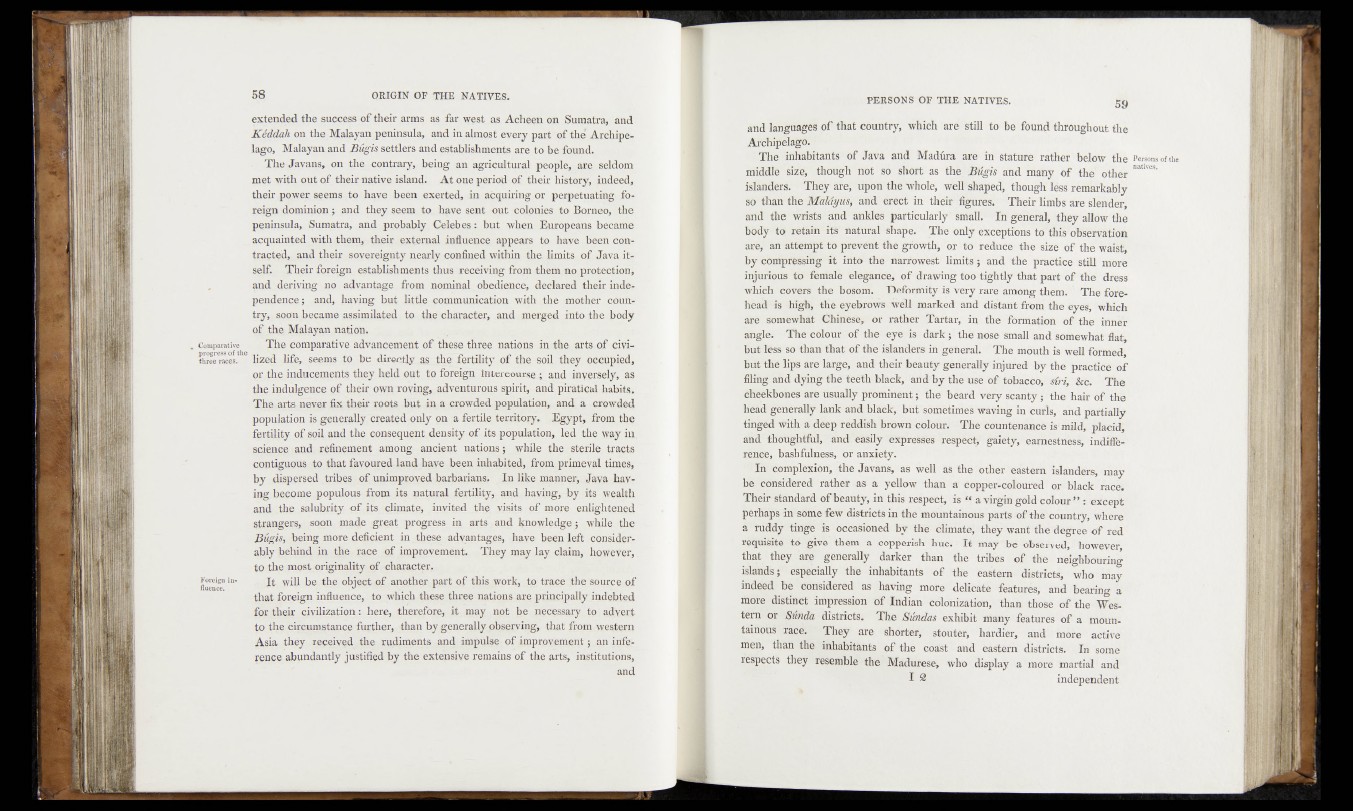
extended the success of their arms as far west as Acheen on Sumatra, and
Kdddah on the Malayan peninsula, and in almost every part of the Archipelago,
Malayan and Bugis settlers and establishments are to be found.
- The Javans, on the contrary, being an agricultural people, are seldom
met with out of their native island. At one period of their history, indeed,
their power seems to have been exerted, in acquiring or perpetuating foreign
dominion; and they seem to have sent out colonies to Borneo, the
peninsula, Sumatra, and probably Celebes: but when Europeans became
acquainted with them, their external influence appears to have been con?
tracted, and their sovereignty nearly confined within the limits of Java itself.
Their foreign establishments thus receiving from them no protection,
and deriving no advantage from nominal obedience, declared their independence
; and, having but little communication with .the mother country,
soon became assimilated to the character, and merged into the body
of the Malayan nation.
. Comparative The comparative advancement of these three nations in the arts of ci©-
three races. 6 lized life, seems to be directly as the fertility of the soil they occupied,
or the inducements they held out to foreign i n t e r c o u r s e ; and inyersely, as
the indulgence of their own roving, adventurous spirit, and piratical habits.
The arts never fix their roots but in a crowded population, and a crowded
population is generally created only on a fertile territory. Egypt, from the
fertility of soil and the consequent density of its population, led the way in
science and refinement among ancient nations; while the sterile tracts
contiguous to that favoured land have been inhabited, from primeval times,
by dispersed tribes of unimproved barbarians. In like manner, Java having
become populous from its natural fertility, and having, by ifef wealth
and the salubrity o f its climate, invited the visits of more enlightened
strangers, soon made great progress in arts and knowledge; while the
Bugis, being more deficient in.these advantages, have been left considerably
behind in the race of improvement. They may lay claim, however,
to theunosloriginality of character,
flu™«?in" H will he.the objectof another part of this work, to trace ihC sourpe^of
that foreign influence, to which these three nations are principally indebted
for their civilization: here, therefore, it may not be necessary to advert
to the circumstance further, than by generally observing, that from western
Asia they received the rudiments and impulse of improvement; an inference
abundantly justified by the extensive remains of the arts, institutions,
and
and languages of that country, which are still to be foun(l throughout the
Archipelago.
The inhabitants of Java and Madura are in stature rather below the Persons of the
middle size, though not so short as the. Bugis and many of the other natires‘
islanders. They are, upon the whole, Well shaped, though less remarkably
só than the Maldyus, and erect in their figures. Their limbs are slender,
and the wrists and ankles particularly small. In general, they allow the
body to retain its1 natural shape. The only exceptions to this observation
are,"' an attempt to prevent the growth, or to reduce the size of the waist,
by compressing it into the narrowest limits; and the practice still more
injurious to female elegance, of drawing too tightly that part of the dress
which covers the bosom. Deformity Is very Tare among them. The forehead
is high, the éyebrows well marked and distant from the eyes, which
are somewhat Chinese, or rather 'Tartar, in the formation Of the inner
angle. The colour of the eye is dark; the nose small and sotnewhat flat,
but léss^ so than that of the islanders in general. The mouth is well formed,
but the lips are large, and their beauty generally injured by the practice of
filing and dying the teeth black, and by theUse of tobacco, siri, &c. The
Cheekbones are usually prominent; the beard very scanty ; the hair of the
head generally lank and black, but sometimes waving in curls, and partially
tinged with a deep reddish brown colour. The countenance is'ihild, placid,
atti thoughtful, and easily expresses respect;- gaiety, eafnestness, indiffe-1 .
rence, bashfulness, or anxiety.
In complexion, the Javans, as well as the other eastern islanders, may
be-Considered rather as a yellow than a' copper-coloured or black race;
Their standard of beauty, in this respect, te: a virgin gold'Colour’’ : except
perhaps in some few districts in the mountainous parts ofthe* country, where
a riiddy tinge is occasioned by the climate, they want the tiegreb of red
requisite to give them a eopperish-hue. It may be observed, however
that they are generally darker than the tribes of the neighbouring
islands; especially the inhabitants óf the eastern districts, who may
indeed be considered as having mote delicate features, and bearing a
more distinct impression of Indian colonization, than those of the Western
or Sunda districts. The Swndas exhibit many features of a mountainous
rage. They are shorter, stouter, hardier, and more active
men, than the inhabitants of the cotfst and eastern districts. In some
respects they resemble the Madurese, who display a more martial and
I * independent